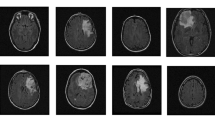Abstract
A brain tumor develops when cells multiply rapidly out of control. There is a risk of death if it is not treated in the early stages. Accurate segmentation and classification are still difficult, despite many significant efforts and promising outcomes. The wide range of tumor locations, shapes and sizes causes a significant obstacle in the field of brain tumor diagnosis. The goal of this study is to provide a comprehensive analysis of brain tumor detection malignant or benign using different features of the dataset. Our proposed model focused on the application of Machine Learning Techniques using an ensemble method to develop and classify them into malignant or benign brain tumors. The overall analysis is divided into two parts: first, we extract 30 attributes related to brain tumors from MR images, where datasets are publicly available. After that, we used the ensemble method to detect the tumors from said attributes and segment them into two categories malignant or benign tumors. The outputs of our model give robustness and cross-validation revealing to the accuracy, precision, recall, and AUC as 95.26%, 95.55%, 97.21%, and 96%, respectively. This study proposed a method of dividing the brain tumor with minimal human intervention. The goal of the proposed model is to reduce identification time so that neurosurgeons can get back to saving lives. The experimental results suggest that the method is nearly as accurate as the best existing methods.













Similar content being viewed by others
Data availability
The datasets used and analyzed during the current study are available from the corresponding author on reasonable request (https://figshare.com/articles/dataset/brain_tumor_dataset/1512427).
References
Higano S, Yun X, Kumabe T, Watanabe M, Mugikura S, Umetsu A, Sato A, Yamada T, Takahashi S. Malignant astrocytic tumours: clinical importance of apparent diffusion coefficient in the prediction of grade and prognosis. Radiology. 2006;241:839–46. https://doi.org/10.1148/radiol.2413051276.
Weber MA, Zoubaa S, Schlieter M, Jüttler E, Huttner HB, Geletneky K, Ittrich C, Lichy MP, Kroll A, Debus J, Giesel FL, Hartmann M, Essig M. Diagnostic performance of spectroscopic and perfusion MRI for a distinction of brain tumours. Neurology. 2006;66:1899–906. https://doi.org/10.1212/01.wnl.0000219767.49705.9c.
Cho YD, Choi GH, Lee SP, Kim JK. 1H-MRS metabolic patterns for distinguishing between meningiomas and other brain tumours. Magn Reson Imaging. 2003;21:663–72. https://doi.org/10.1016/s0730-725x(03)00097-3.
Zacharaki EI, Wang S, Chawla S, Soo Yoo D, Wolf R, Melhem ER, Davatzikos C. Classification of brain tumour type and grade using MRI texture and shape in a machine learning scheme. Magn Reson Med. 2009;62(6):1609–18. https://doi.org/10.1002/mrm.22147.
Amin J, Sharif M, Yasmin M, Fernandes SL. A distinctive approach in brain tumour detection and classification using MRI. Pattern Recogn Lett. 2017;139:118–27. https://doi.org/10.1016/j.patrec.2017.10.036.
Provenzale JM, Mukundan S, Baroriak DP. Diffusion-weighted and perfusion MR imaging for brain tumor characterization and assessment of treatment response. Radiology. 2006;239:632–49. https://doi.org/10.1148/radiol.2393042031.
Vannier MW, Pilgram TK, Speidel CM, Neumann LR, Rickman DL, Schertz LD. Validation of magnetic resonance imaging (MRI) multispectral tissue classification. Comput Med Imaging Graph. 1991;15(4):217–23.
Shahriar Sazzad TM, TanzibulAhmmed KM, Hoque MU, Rahman M. Development of Automated Brain Tumor Identification Using MRI Images, (2019). International Conference on Electrical, Computer and Communication Engineering (ECCE), Cox’sBazar, Bangladesh, 1–4, https://doi.org/10.1109/ECACE.2019.8679240.
Tiwari A, Srivastava S, Pant M. Brain tumour segmentation and classification from magnetic resonance images: review of selected methods from 2014 to 2019. Pattern Recogn Lett. 2020;131:244–60.
Shanmuga PS, Saran RS, Surendiran B, Arulmurugaselvi N. Brain tumour detection in MRI using deep learning. Adv Intell Syst Comput. 2021. https://doi.org/10.1007/978-981-15-5788-0_38.
Abdalla HEM, Esmail MY (2018) Brain Tumor Detection by using Artificial Neural Network, International Conference on Computer, Control, Electrical, and Electronics Engineering (ICCCEEE). 1–6. https://doi.org/10.1109/ICCCEEE.2018.8515763.
Akbar S, Nasim S, Wasi S, Zafar SMU (2019) Image Analysis for MRI Based Brain Tumor Detection, 4th International Conference on Emerging Trends in Engineering, Sciences and Technology (ICEEST), 1–5, https://doi.org/10.1109/ICEEST48626.2019.8981681.
Gurbină M, Lascu M, Lascu D (2019) Tumor Detection and Classification of MRI Brain Image using Different Wavelet Transform and Support Vector Machines, 42nd International Conference on Telecommunications and Signal Processing (TSP), 505–508. https://doi.org/10.1109/TSP.2019.8769040
Dvorak P, Kropatsch W, Bartusek K (2013) Automatic detection of brain tumors in MR images, 36th International Conference on Telecommunications and Signal Processing (TSP). 577–580, https://doi.org/10.1109/TSP.2013.6614000.
Ezhilarasi R, Varalakshmi P (2018) Tumor Detection in the Brain using Faster R-CNN. 388–392. https://doi.org/10.1109/I-SMAC.2018.8653705
Vinoth R, Venkatesh C (2018) Segmentation and Detection of Tumor in MRI images Using CNN and SVM Classification. Conference on Emerging Devices and Smart Systems (ICEDSS). 21–25, https://doi.org/10.1109/ICEDSS.2018.8544306
Divyamary D, Gopika S, Pradeeba S, Bhuvaneswari M (2020) Brain Tumor Detection from MRI Images using Naive Classifier, 6th International Conference on Advanced Computing and Communication Systems (ICACCS), 620–622, https://doi.org/10.1109/ICACCS48705.2020.9074213
Das A, Dantcheva A, Brémond F. Mitigating bias in gender, age and ethnicity classification: a multi-task convolution neural network approach. ECCV Workshops. 2018. https://doi.org/10.1007/978-3-030-11009-3_35.
Tarik H, Tawfik M, Youssef D, Mohammed S, Mohammed OJ, Miloud JE. Towards an improved CNN architecture for brain tumor classification. Learn Anal Intell Syst. 2020. https://doi.org/10.1007/978-3-030-36778-7_24.
Muhammad Arif F, Ajesh SS, Geman O, Izdrui D, Vicoveanu D. Brain tumor detection and classification by MRI using biologically inspired orthogonal wavelet transform and deep learning techniques. J Healthc Eng. 2022;2022:1–18. https://doi.org/10.1155/2022/2693621.
Author information
Authors and Affiliations
Corresponding author
Ethics declarations
Conflict of interest
The authors declare no conflict of interest.
Additional information
Publisher's Note
Springer Nature remains neutral with regard to jurisdictional claims in published maps and institutional affiliations.
This article is part of the topical collection “Machine Learning Modeling Techniques and Applications” guest edited by Lazaros Iliadis, Elias Pimenidis and Chrisina Jayne.
Rights and permissions
Springer Nature or its licensor (e.g. a society or other partner) holds exclusive rights to this article under a publishing agreement with the author(s) or other rightsholder(s); author self-archiving of the accepted manuscript version of this article is solely governed by the terms of such publishing agreement and applicable law.
About this article
Cite this article
Nayak, B., Dash, G.P., Ojha, R.K. et al. Application of Machine Learning Techniques for Detection and Segmentation of Brain Tumors. SN COMPUT. SCI. 4, 520 (2023). https://doi.org/10.1007/s42979-023-01918-7
Received:
Accepted:
Published:
DOI: https://doi.org/10.1007/s42979-023-01918-7




